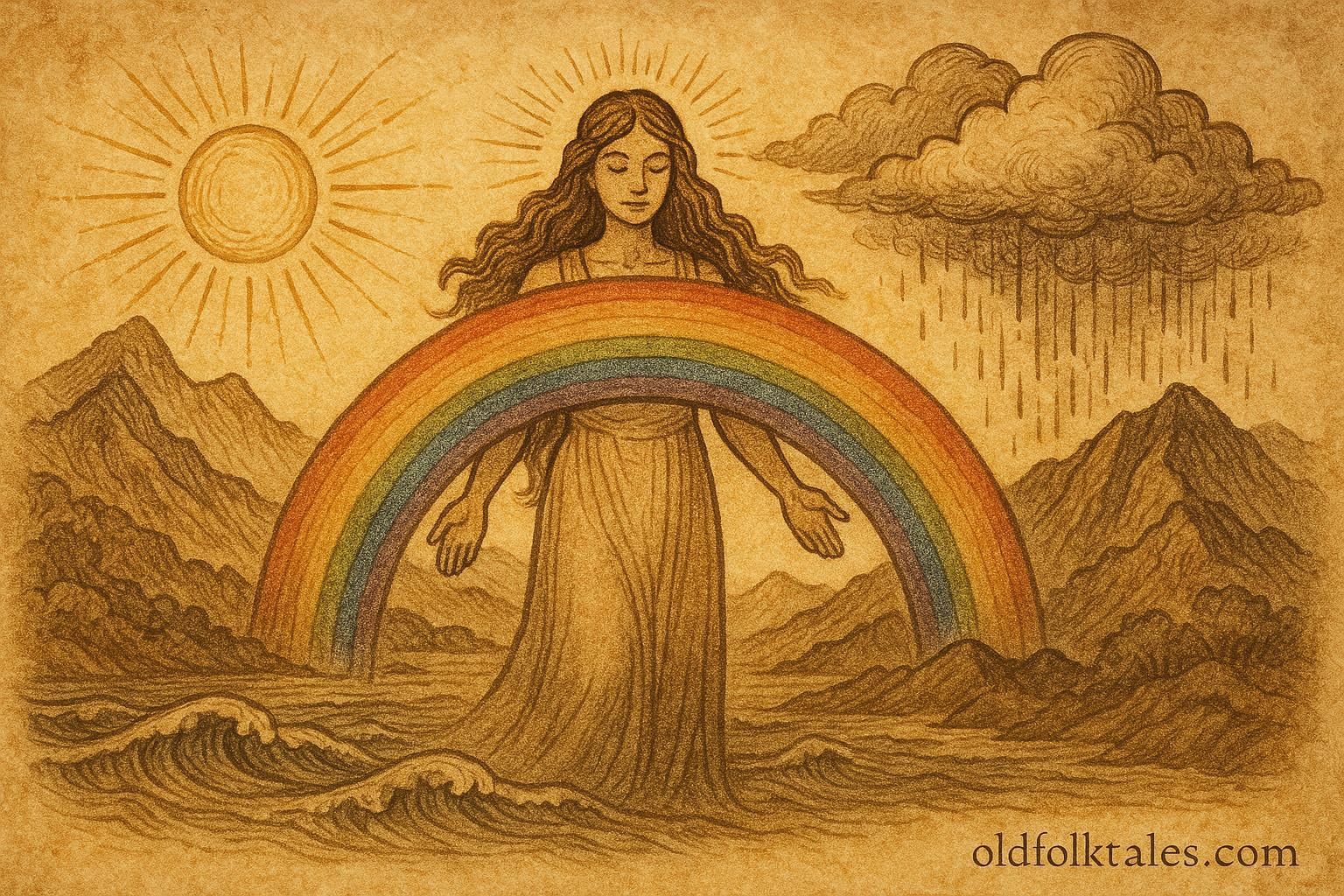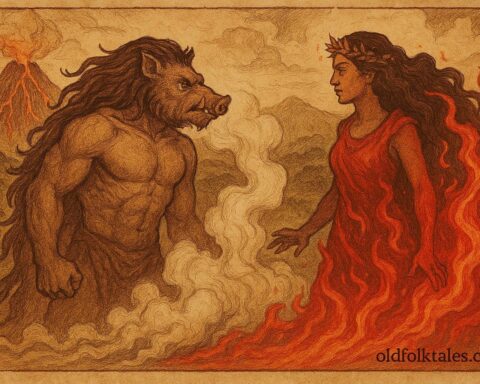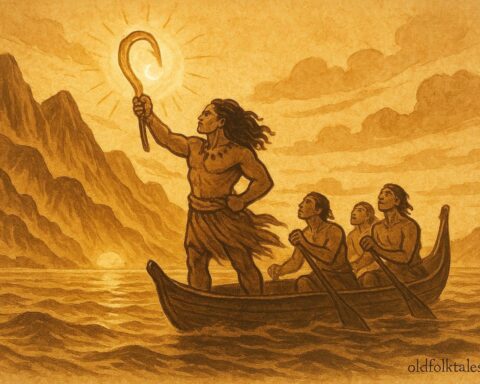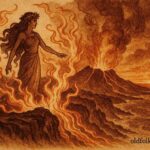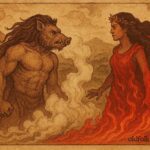Long ago, when the islands of Hawai‘i were young and the seas shimmered with divine light, there lived a maiden unlike any other, her name was Anuenue, the Rainbow Maiden. She was born from the sacred union of sunlight and rain, the two eternal lovers who danced across the skies of the Pacific. Her birth marked the promise of balance, a bridge between heaven and earth, joy and sorrow, life and death.
Anuenue’s beauty was not merely of the flesh. Her form shimmered with every color of the rainbow, soft reds of dawn, golden yellows of noon, tranquil greens of the valleys, and deep violets of twilight. When she appeared in the sky, her light curved gently across the heavens, bringing peace to fishermen, farmers, and travelers who saw her glow. To the Hawaiian people, she was a divine messenger, a sign that the gods still walked among mortals.
The Birth of Anuenue
The tale begins when Kāne, god of sunlight, cast his golden rays upon the sea during a time of endless rain. The rain goddess Uli, lonely in her constant weeping, sent her gentle drops to cool the heated sky. When sunlight touched her tears, a shimmering band of color appeared, a bridge connecting sky and sea. From this bridge, a radiant maiden stepped forth, her laughter carrying through the winds.
“Who are you?” asked Kāne, gazing at the luminous being before him.
“I am the child of your light and her rain,” Anuenue replied. “I am the harmony you both have long sought, the joining of heaven’s fire and earth’s tears.”
Her parents rejoiced, for Anuenue’s presence symbolized peace between storm and sunlight. From that day on, she roamed between the clouds and mountains, bringing beauty and balance wherever she went.
The Bridge Between Worlds
Anuenue’s role was sacred. She became the messenger of the gods, carrying words of the heavens to the earth and guiding spirits from the mortal realm to the divine. When a soul was ready to leave the body, she extended her radiant bridge, allowing it to pass into the light. To some, her colors symbolized hope after sorrow; to others, they marked the fleeting beauty of life.
The people of Hawai‘i honored her with chants and offerings of flowers. When a rainbow appeared after a heavy storm, mothers would tell their children, “Look, Anuenue walks the sky. She brings peace after the tears of the clouds.”
But not all spirits welcomed her light. Some dark forces, born from shadow and jealousy, envied her beauty. Among them was Moho, a mist spirit who lived in the valleys and thrived on confusion. He whispered to travelers, hiding the path home, and shrouded villages in fog. Moho feared that Anuenue’s light would banish him forever.
The Jealousy of Moho
One day, as Anuenue descended to bless a valley after a long drought, Moho spread his grey veil across the mountains, dimming her colors. “Leave this place,” he hissed. “There is no need for your brightness here. The people belong to me, to my mists, my forgetfulness.”
But Anuenue only smiled, her glow piercing the fog. “Without rain, there is no rainbow,” she said softly. “Even your mist plays a part in the dance of creation.”
Her words angered Moho further. He gathered all his clouds and covered the island in darkness. The rivers swelled, and the winds howled. For days, the people could not see the sun or stars, only endless storm.
The Triumph of Light
When the cries of the people reached the heavens, Kāne sent his blazing rays to cut through the storm. Uli poured gentle rain to calm the fury of the wind. But the light and water alone could not restore balance, they needed their daughter.
Summoning all her strength, Anuenue rose through the clouds, her colors dimmed yet unbroken. She called upon the spirit of harmony that gave her life, the union of opposites. Stretching across the sky, she formed a radiant bridge from one island peak to another. The light of Kāne met the rain of Uli, and together they dispelled Moho’s darkness.
As the storm cleared, the people looked up and saw the most magnificent rainbow ever known. Its colors sang like waves against coral, a hymn of peace, unity, and rebirth. From that day, Moho retreated into the mountain shadows, appearing only when the land forgot gratitude for balance.
Anuenue’s Eternal Gift
Though Anuenue was divine, she felt a deep affection for humankind. She understood that mortals often lived in the space between joy and sorrow, just as she lived between light and rain. So she vowed to appear after every storm, reminding the people that beauty is born from the meeting of opposites.
When someone died, families would look for a rainbow in the sky. “Anuenue guides their spirit home,” they would say. When lovers quarreled, elders reminded them, “Rain and sun must meet before a rainbow can appear.”
And so, through the ages, the Rainbow Maiden remained a symbol of harmony, the eternal promise that peace and beauty emerge not from sameness, but from unity in difference.
Discover the adventures of Māui, Pele, and Tangaloa in the timeless Polynesian oral tradition
Moral Lesson
The legend of Anuenue teaches that harmony is not found in perfection, but in balance, between joy and sorrow, light and darkness, rain and sun. Just as the rainbow only appears when the storm meets the sunlight, true peace comes when we embrace both sides of life’s nature.
Knowledge Check (Q&A)
- Who is Anuenue in Hawaiian mythology?
Anuenue is the Rainbow Maiden, a divine being born from sunlight and rain who bridges heaven and earth. - What natural phenomenon does Anuenue represent?
She represents the rainbow,the union of sunlight and rain, symbolizing balance and harmony. - What lesson does the story of Anuenue teach?
It teaches that harmony and beauty arise from the unity of opposites, like light and darkness or joy and sorrow. - Who are Anuenue’s divine parents?
Her parents are Kāne, the god of sunlight, and Uli, the goddess of rain. - What does the mist spirit Moho symbolize?
Moho represents jealousy, confusion, and imbalance, forces that cloud clarity and harmony. - Why do Hawaiians see rainbows as sacred signs?
Because they believe Anuenue’s rainbow bridge connects mortals to the divine and brings peace after hardship.
Source: Adapted from Hawaiian Legends of Old Honolulu and Maui by W. D. Westervelt (1916).
Cultural Origin: Hawaiian (Polynesian)
